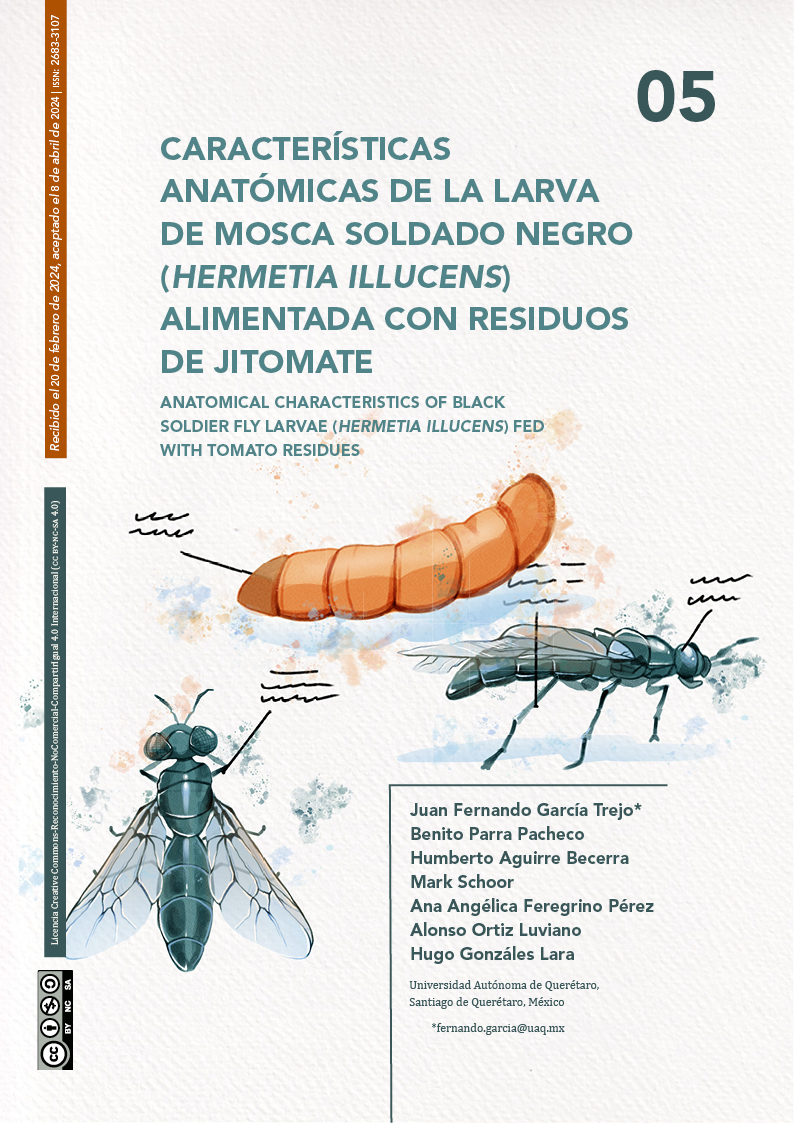Resumen
Las características anatómicas de la larva de mosca soldado negro nos permiten entender si el desarrollo que tiene durante su cultivo en residuos de la planta de jitomate está siendo adecuado. En este estudio el mayor peso de la larva se obtuvo en el residuo de fruto, mientras que los más bajos se presentaron en las larvas alimentadas con tallo; siendo este dónde se presentó el mayor intervalo de mortalidad, seguido de las larvas alimentadas con hojas y por último las larvas alimentadas con jitomate. Por otro lado, el largo de las larvas presentó un gradiente de tamaño, las más pequeñas se presentaron en tallo, seguido de hoja y finalmente fruto; sin embargo, las más grandes fueron obtenidas del control. En cuanto al ancho de las larvas el valor mayormente representado en todos los alimentos y dosis fue de 4 mm, mientras que el control presentó valores cercanos a los 5 mm.
Referencias
S. A. Siddiqui et al., "Black soldier fly larvae (BSFL) and their affinity for organic waste processing," Waste Management, vol. 140, pp. 1-13, 2022/03/01/ 2022. doi: https://doi.org/10.1016/j.wasman.2021.12.044
Food and Agriculture Organization, "La agricultura mundial en la perspectiva del año 2050," ed: FAO, 2009
I. Kinasih et al., "Performance of Black Soldier Fly, Hermetia illucens, Larvae during valorization of organic wastes with changing quality," IOP Conference Series: Earth and Environmental Science, vol. 593, no. 1, p. 012040, 2020/11/01 2020. doi: 10.1088/1755-1315/593/1/012040
B. Pastor, Y. Velasquez, P. Gobbi, S. J. J. o. I. a. F. Rojo, and Feed, "Conversion of organic wastes into fly larval biomass: bottlenecks and challenges," vol. 1, no. 3, pp. 179-193, 2015.
C. Y. Chun, L. S. Yoong, L. P. Kim, T. L. Hock, and L. J. Ling, "Comparison of Hermetia illucens larvae and pre-pupae as potential aqua feed derived from the biotransformation of organic waste," in AIP Conference Proceedings, 2019, vol. 2157, no. 1: AIP Publishing.
R. Bian et al., "Greenhouse gas emissions from waste sectors in China during 2006–2019: Implications for carbon mitigation," Process Safety and Environmental Protection, vol. 161, pp. 488-497, 2022/05/01/ 2022. doi: https://doi.org/10.1016/j.psep.2022.03.050
S. Dahiya, A. N. Kumar, J. Shanthi Sravan, S. Chatterjee, O. Sarkar, and S. V. Mohan, "Food waste biorefinery: Sustainable strategy for circular bioeconomy," Bioresource Technology, vol. 248, pp. 2-12, 2018/01/01/ 2018. doi: https://doi.org/10.1016/j.biortech.2017.07.176
M. K. Rakkar and H. Blanco-Canqui, "Grazing of crop residues: Impacts on soils and crop production," Agriculture, Ecosystems & Environment, vol. 258, pp. 71-90, 2018/04/15/ 2018. doi: https://doi.org/10.1016/j.agee.2017.11.018
E. Graminha et al., "Enzyme production by solid-state fermentation: Application to animal nutrition," vol. 144, no. 1-2, pp. 1-22, 2008.
E. Kasapidou, E. Sossidou, and P. Mitlianga, "Fruit and Vegetable Co-Products as Functional Feed Ingredients in Farm Animal Nutrition for Improved Product Quality," vol. 5, no. 4, pp. 1020-1034, 2015.
M. Godoy, G. Amorim, M. Barreto, and D. J. S.-S. F. E. Freire, "Agricultural residues as animal feed: protein enrichment and detoxification using solid-state fermentation. Current developments in biotechnology and bioengineering," pp. 235-256, 2018.
W. C. F. Mizael et al., "Effect of the Use of Tomato Pomace on Feeding and Performance of Lactating Goats," (in eng), Animals (Basel), vol. 10, no. 9, Sep 3 2020. doi: 10.3390/ani10091574
M. R. Ventura, M. C. Pieltain, and J. I. R. Castanon, "Evaluation of tomato crop by-products as feed for goats," Animal Feed Science and Technology, vol. 154, no. 3, pp. 271-275, 2009/11/26/ 2009. doi: https://doi.org/10.1016/j.anifeedsci.2009.09.004
A. D. Moreno, A. Duque, A. González, I. Ballesteros, and M. J. Negro, "Valorization of Greenhouse Horticulture Waste from a Biorefinery Perspective," (in eng), Foods, vol. 10, no. 4, Apr 9 2021. doi: 10.3390/foods10040814
A. Manríquez-Altamirano, J. Sierra-Pérez, P. Muñoz, and X. Gabarrell, "Identifying potential applications for residual biomass from urban agriculture through eco-ideation: Tomato stems from rooftop greenhouses," Journal of Cleaner Production, vol. 295, p. 126360, 2021/05/01/ 2021. doi: https://doi.org/10.1016/j.jclepro.2021.126360
I. Tabrika, K. Azim, E. H. Mayad, and M. J. O. A. Zaafrani, "Composting of tomato plant residues: Improvement of composting process and compost quality by integration of sheep manure," vol. 10, pp. 229-242, 2020.
Z. Kassab, I. Kassem, H. Hannache, R. Bouhfid, A. E. K. Qaiss, and M. J. C. El Achaby, "Tomato plant residue as new renewable source for cellulose production: extraction of cellulose nanocrystals with different surface functionalities," vol. 27, pp. 4287-4303, 2020.
M. D. S. Soto, A. A. Zorpas, J. N. Pedreño, and I. G. Lucas, "Vermicomposting of tomato wastes," in Tomato Processing By-Products: Elsevier, 2022, pp. 201-230
J. Y. Méndez-Carmona et al., "Valorization of Tomato Fruit Processing Residues," in Agricultural Waste: Environmental Impact, Useful Metabolites and Energy Production, K. G. Ramawat, J.-M. Mérillon, and J. Arora, Eds. Singapore: Springer Nature Singapore, 2023, pp. 215-243. doi: 10.1007/978-981-19-8774-8_10
C. Lalander, S. Diener, M. E. Magri, C. Zurbrügg, A. Lindström, and B. J. S. o. t. T. E. Vinnerås, "Faecal sludge management with the larvae of the black soldier fly (Hermetia illucens)—From a hygiene aspect," vol. 458, pp. 312-318, 2013.
M. Gold et al., "Biowaste treatment with black soldier fly larvae: Increasing performance through the formulation of biowastes based on protein and carbohydrates," Waste Management, vol. 102, pp. 319-329, 2020/02/01/ 2020. doi: https://doi.org/10.1016/j.wasman.2019.10.036
P. Borel et al., "Using black soldier fly larvae reared on fruits and vegetables waste as a sustainable dietary source of provitamin a carotenoids," (in eng), Food Chem, vol. 359, p. 129911, Oct 15 2021. doi: 10.1016/j.foodchem.2021.129911
L. Broeckx et al., "Growth of Black Soldier Fly Larvae Reared on Organic Side-Streams," vol. 13, no. 23, p. 12953, 2021
ALI, Md Yousuf, et al. Nutritional composition and bioactive compounds in tomatoes and their impact on human health and disease: A review. Foods, 2020, vol. 10, no 1, p. 45.
Addeo, Nicola Francesco, et al. "Different combinations of butchery and vegetable wastes on growth performance, chemical-nutritional characteristics and oxidative status of black soldier fly growing larvae." Animals 11.12 (2021): 3515.

Esta obra está bajo una licencia internacional Creative Commons Atribución-NoComercial-CompartirIgual 4.0.
Derechos de autor 2024 Perspectivas de la Ciencia y la Tecnología

